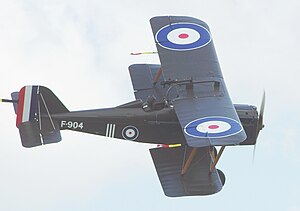Royal Aircraft Factory SE.5a
| Royal Aircraft Factory S.E.5 | |
|---|---|
 |
|
| S.E.5a number F904, Old Warden Aerodrome, Bedfordshire, England (2009) | |
| Role | Single-seat fighter |
| Manufacturer | various (see text) |
| Designer | Henry Folland / John Kenworthy |
| First flight | 22 November 1916 |
| Introduction | March 1917 |
| Primary users |
Royal Flying Corps United States Army Air Service Royal Australian Air Force Royal Canadian Air Force |
| Number built | 5,205 |
|
|
|
|
|
|
|
|
The Royal Aircraft Factory S.E.5 was a British biplane fighter aircraft of the First World War. It was developed by the Royal Aircraft Factory by a team consisting of Henry Folland, John Kenworthy and Major Frank Goodden. It was one of the fastest aircraft of the war, while being both stable and relatively manoeuvrable. According to aviation author Robert Jackson, the S.E.5 was: "the nimble fighter that has since been described as the 'Spitfire of World War One'".
The S.E.5 was capable of superior overall performance than the rival Sopwith Camel, both aircraft being capable dogfighters of the era; however, problems with its Hispano-Suiza engine, particularly the geared-output H-S 8B-powered early versions, meant that there was a chronic shortage of S.E.5s until well into 1918. Thus, while the first examples had reached the Western Front before Camel, there were fewer squadrons were equipped with the S.E.5 than those that had been provided with the Sopwith fighter instead.
Together with the Camel, the S.E.5 was instrumental in regaining allied air superiority in mid-1917 and maintaining it for the rest of the war, ensuring there was no repetition of "Bloody April" 1917 when losses in the Royal Flying Corps were much heavier than in the Luftstreitkräfte. The S.E.5s remained in RAF service for some time following the Armistice that ended the conflict, but began to be withdrawn soon afterwards. Quantities of ex-RAF aircraft were transferred to various overseas military operators, a number were also adopted by civilian operators.
...
Wikipedia
